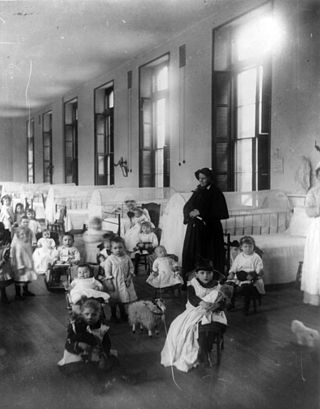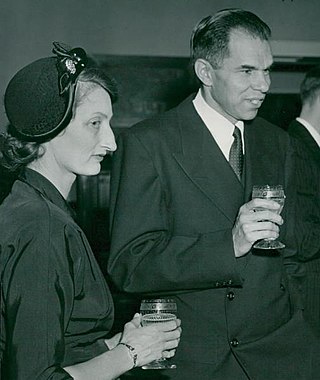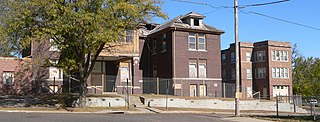
The National Florence Crittenton Mission was an organization established in 1883 by Charles N. Crittenton. It attempted to reform prostitutes and unwed pregnant women through the creation of establishments where they were to live and learn skills.

The National Florence Crittenton Mission was an organization established in 1883 by Charles N. Crittenton. It attempted to reform prostitutes and unwed pregnant women through the creation of establishments where they were to live and learn skills.

The first of the organization's homes was located in New York City. Seven years later, in 1890, the second Florence Crittenton Home was opened in San Jose, California. Shortly thereafter, pioneering female physician Kate Waller Barrett joined Charles Crittenton as the driving force behind the organization and helped expand the Crittenton movement into a network of affiliated homes that at its peak included 76 homes across the U.S., in addition to homes in China, France, Japan and Mexico. [1]
This turn of the 20th century social welfare movement helped shape the professionalization of social work, and changed social attitudes about motherhood and the role of women in society. Barrett's views on the education and training of women were considered radical at the time, but these ideas were adopted into the services provided to young women and girls at many Crittenton homes. [2]

A special act of Congress in 1898, signed by President McKinley, granted a national charter in perpetuity to the National Florence Crittenton Mission, and was the first U.S. national charter ever given to a charitable organization. The headquarters of the national mission was in Washington, D. C. The largest work of the mission was carried out in New York City.
In 1950, there were two organizations associated with the original mission: the National Florence Crittenton Mission and the Florence Crittenton Homes Association, which had its headquarters in Chicago, Illinois. In 1976, the Florence Crittenton Association of America merged with the Child Welfare League of America. The Florence Crittenton Mission continued to provide financial support to the Crittenton Division of the Child Welfare League. [1]
In 2006, The National Florence Crittenton Mission adopted a new name: The National Crittenton Foundation. [1] The organization separated from the Child Welfare League of America and returned to being a stand-alone organization affiliated with dozens of Crittenton-affiliated agences around the country. The National Crittenton Foundation's headquarters are located in Portland, Oregon.
The National Florence Crittenton Mission's approach to adoption and to unwed pregnancy has been criticized largely due to policies used decades ago. In the past, rather than to aid pregnant women, families sent them to Crittenton homes to hide them from public view and avoid shame. [3] Many of the women in these homes were required to give up their children for adoption. [4] The coercive practices of these homes were detailed in The Girls Who Went Away . This mirrored a practice found in Europe generally and in Italy specifically occurring from the Middle Ages to its full flowering in the 19th century. (See Kertzer, David I. Sacrificed for Honor: Italian Infant Abandonment and the Politics of Reproductive Control. Boston: Beacon Press, 1993.)

Adoption is a process whereby a person assumes the parenting of another, usually a child, from that person's biological or legal parent or parents. Legal adoptions permanently transfer all rights and responsibilities, along with filiation, from the biological parents to the adoptive parents.

Beulah George "Georgia" Tann, was an American social worker and child trafficker who operated the Tennessee Children's Home Society, an adoption agency in Memphis, Tennessee. Tann used the unlicensed home as a front for her black market baby adoption scheme from the 1920s. Young children were kidnapped and then sold to wealthy families, abused, or—in some instances—murdered. A state investigation into numerous instances of adoption fraud led to the closure of the institution in 1950. Tann died of cancer before the investigation made its findings public.

Helen L. Seaborg was an American child welfare advocate and the wife of Nobel Prize chemist Glenn T. Seaborg.
Tennessee Children's Home Society was a chain of orphanages that operated in the state of Tennessee during the first half of the twentieth century. It is most often associated with Georgia Tann, its Memphis branch operator and child trafficker who was involved in the kidnapping of children and their illegal adoptions.

Charles Nelson Crittenton was a manufacturer and distributor of drugs and patent medicines, a Protestant evangelist, and a philanthropist, best known for his founding with physician Katherine Waller Barrett of the National Florence Crittenton Mission.
Family preservation was the movement to help keep children at home with their families rather than in foster homes or institutions. This movement was a reaction to the earlier policy of family breakup, which pulled children out of unfit homes. Extreme poverty alone was seen as a justified reason to remove children. This new movement began in the 1890s, and in the 1909 White House Conference on Children it was the top ranked issue. In order to keep families together, the family would be given enough money so that the mother would not have to work a full-time job. The families that were given this assistance were usually headed by widows.
The Baby Scoop Era was a period in anglosphere history starting after the end of World War II and ending in the early 1970s, characterized by an increasing rate of pre-marital pregnancies over the preceding period, along with a higher rate of newborn adoption.
National Crittenton is a Portland, Oregon-based American organization that works with at-risk and criminal justice system-involved girls, young women and their families. The foundation is affiliated with 25 member agencies operating across the country in urban and rural areas, including Baltimore; Boston; Charleston, South Carolina; Denver, Colorado; Kansas City, Missouri; Knoxville, Tennessee; Orange County, California and Los Angeles, California; Peoria, Illinois; Philadelphia; Phoenix, Arizona, San Francisco, California; Sioux City, Iowa; Washington, D.C., and Wheeling, West Virginia.

Kate Waller Barrett, née Katherine Harwood Waller, was a prominent Virginia physician, humanitarian, philanthropist, sociologist and social reformer, best known for her leadership of the National Florence Crittenton Mission, which she founded in 1895 with Charles Nelson Crittenton. Her causes included helping the "outcast woman, the mistreated prisoner, those lacking in educational and social opportunity, the voteless woman, and the disabled war veteran." Although comparatively little known today, she was "[o]ne of the most prominent women of her time".
The Child Welfare League of America (CWLA) is a 501(c)(3) charitable organization that coordinates efforts for child welfare in the United States, and provides direct support to agencies that serve children and families. The organization's vision is "that every child will grow up in a safe, loving, and stable family," and its primary objective is to "Make Children a National Priority". The CWLA is run by professionals in the children's services field. As a national organization it lobbies for both child protection, and delivery of services to children. It is the oldest child welfare organization in the United States.
The Girls Who Went Away: The Hidden History of Women Who Surrendered Children for Adoption in the Decades Before Roe v. Wade is a 2006 book by Ann Fessler which describes and recounts the experiences of women in the United States who relinquished babies for adoption between 1950 and the Roe v. Wade decision in 1973.
Origins Canada is a Canadian federal non profit organization providing support and resources to people who have been separated from a family member by adoption practices, including natural parents, persons adopted, and other family members. It was founded in 2002 as a branch of Origins International, which is based in New South Wales, Australia.

DePelchin Children's Center, founded in 1892 in Houston, Texas, is a nonprofit organization focused on supporting and sustaining children and the families who care for them. DePelchin provides a range of services for children and families — it is an accredited foster care and adoption agency, and it also provides residential treatment for youth in foster care, as well as serving youth who are about to age out of foster care or have recently aged out of foster care. DePelchin’s services also include counseling, parenting classes, and other services focused on protecting children and keeping families strong. The center continues to be recognized at the state and federal level for cutting-edge programs, including a federal grant as a leading child trauma expert in Texas.
Crittenton, Inc. was a Boston, Massachusetts–based non-profit organization whose mission was to help young people develop the essential tools that they need to maintain stable housing, find and retain employment, and support the healthy growth of their families.

Aurora "Lola" Greene Baldwin was an American woman who became one of the first policewomen in the United States. In 1908, she was sworn in by the City of Portland as Superintendent of the Women's Auxiliary to the Police Department for the Protection of Girls, with the rank of detective.
The following outline is provided as an overview of and topical guide to adoption:
A maternity home, or maternity housing program, is a form of supportive housing provided to pregnant women. Maternity housing programs support a woman in need of a stable home environment to reach her goals in a variety of areas including education, employment, financial stability, prenatal care, and more. There are over 400 maternity homes in the United States ranging in size and criteria for admittance. Staffing model is a primary way that maternity homes differ. The three major staffing models are houseparents, live-in staff, and shift staff. Additionally, there are a limited number of maternity housing program who operate as a "shepherding" or "host" home. In the "host home" model, women are connected to screened households that offer to provide housing.

Florence Crittenton Home and Maternity Hospital, also known as Crittenton Center and the Samaritan Retirement Home, were historic buildings located in Sioux City, Iowa, United States.
Birth mothers in South Korea (international adoption) refers to the group of biological mothers whose children were placed for adoption in South Korea's international adoption practice. The decades-long phenomenon of international adoption in South Korea began after the Korean War. In the years since the war, South Korea has become the largest and longest provider of children placed for international adoption, with 165,944 recorded Korean adoptees living in 14 countries, primarily in North America and Western Europe, as of 2014.
Adoption in South Korea, specifically the low rates of domestic adoption in their history, has been a point of discussion for the country, causing new policies to be passed over the years. South Korea, at the conclusion of the Korean War in 1953, began to partake in transnational adoption. As these overseas adoptions increased over the next couple of decades, South Korea pushed to encourage fewer transnational adoptions and more domestic adoptions. The high number of children put up for adoption each year in South Korea can be attributed to a variety of factors: the lack of support for unwed mothers, as well as social stigma, contributed greatly to these numbers. Several organizations have been created to support unwed mothers and combat stigma. There has been changes to adoption policies throughout the decades as well. The Special Adoption Act was passed in 2011 with the intention of boosting domestic adoptions. However, the unexpected outcome of more abandoned children ensued following the amendment taking effect.
![]() This article incorporates text from a publication now in the public domain : Colby, F.; Williams, T., eds. (1922). "Florence Crittenton Mission". New International Encyclopedia . Vol. VIII (2nd ed.). New York: Dodd, Mead. p. 704.
This article incorporates text from a publication now in the public domain : Colby, F.; Williams, T., eds. (1922). "Florence Crittenton Mission". New International Encyclopedia . Vol. VIII (2nd ed.). New York: Dodd, Mead. p. 704.
Finding aid for the National Florence Crittenton Mission records at the Social Welfare History Archives, University of Minnesota Libraries.